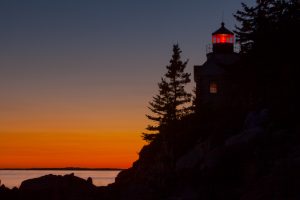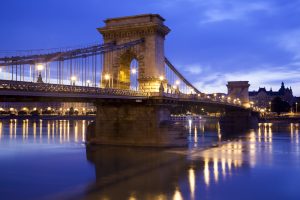
Sunset, Bass Harbor Lighthouse, Maine
Joyce and I were on a motorcycle trip to Bar Harbor, ME. After doing some research we decided to view and photograph the sunset at Bass Harbor. In full motorcycle garb carrying camera gear and a tripod, we descended the stairs and then climbed down on to the rocks to set up, compose, and wait. There were lots of people there to view the sunset and they were pretty much in the way of getting a nice photo. But, the best time to photograph a sunset is after the sun sinks in to the horizon. When that happened all that were left were a few “real” photographers who know that the best time to shoot a sunset is during the “blue hour”-about 30 – 40 minutes after the sun sinks below the horizon. The image displayed is the very last in the series that was captured that evening. I timed the red light in the lighthouse to make sure that it was lit in the photograph. There is minimal post processing to this image-pretty much straight out of the camera. The climb back up the rocks and stairs were a bit tricky in the dark in our M/C gear and the mosquitos were ferocious when the sun went down. But it was all well worth the great shot. The workflow that I used that night is the same that I use for just about every one of my sunrise and sunset photos:
- I always research the locations ahead of time to visualize and decide the type of image I want to capture. This will include reviewing images posted on the internet.
- I typically arrive about 60 minutes before the sunrise or the sunset. Sometimes I will arrive 90 minutes before if I think the location may be a bit crowded.
- I will set up and begin shooting to fine tune the composition. Sometimes these shots turn out great depending on how the light is falling, changing color and creating shadows. The best shots and the best colors are the 30 – 40 minutes after the sun sets. This is when the camera picks up colors that the eye may not see. I am always looking for a unique composition. Shooting a sun sinking in to the water with nothing else going on… well we have all seen a hundred if not a thousand of those.
- In your composition, make sure that the horizon is level. And make sure that everything you want in the frame is in the frame, and everything that you would not want in the frame, then leave it out.
- I always shoot this time of the day using a tripod with a cable release; this eliminates any chance of a blurry image. If you have the feature, turn on mirror lockup and do not use image stabilization when on a tripod.
- I always shoot on manual mode and use settings that will provide the sharpest image for the camera and lens that I am using. In this case I was using my Canon 5DMKII with a Canon 70mm-200mm lens @ 75mm; ISO 100; F22 @ 2s. Even though F11 would have been sharper for this lens, I chose F22 to capture as much depth of field as possible. I wanted the outline of the rocks, the lighthouse, the tree, and the horizon to all be in focus at the same time. F11 probably would have accomplished that but I wasn’t taking any chances.
- I always bracket my shots: shoot one image lighter and one image darker than what the camera is telling me for a total of 3 shots. I start by exposing for the sky and then adjust from there by reviewing each group of shots. The resulting exposure was 2 seconds.

Sunrise, Chaine Bridge, Budapest, Hungry
Canon 5DMKII; Canon 24mm-105mm lens @ 40mm; ISO 100; F11 @ 15s; on a tripod
Join me for a tutoring session, a photoshoot, or Berlin in May.
